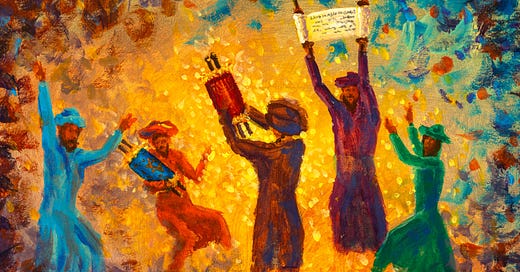Dancing with the sacred. There was only one time when I attended services on this holiday that the congregation engaged in traditional dancing with the Torah as part of its evening, but it sticks with me always for the sheer exuberance and expansiveness of dancing with the ancient scrolls, a celebration of meaning across time, bodily joy whirling in the blend of spirit and text — a dance bathed in light. Ultimately, the beauty of this movement of body and soul goes beyond exultation in a sacred book, but to the revelation of how meaning transmits through books, timelessly. Dancing with the Torah, dancing with the scrolls, this is dancing with an ancient book, exulting in the abundance of a book. Religious dogma cannot contain the jubilance for revelation. This is a different order of reading: dancing with a book! Dancing is reading — and reading should be, can be, a dance — communing with words, swirling in the spirit of the text, tilt-a-whirl of The Word. The most life-tingly words leap off the page, make us want to leap to our feet while reading. What cause for gratitude, when we have occasion for rejoicing in eloquence or pure utterance in all its glory; it doesn’t matter if the texts are sacred or secular.1 Let them be secular! Dancing with the secular, to keep the secular sacred for freedom of thought. To dance with books is to dance in freedom and joy for our freedom of thought.
How hopelessly retro to revel in actual books! The paper, the parchment. The environmental impact of the book industry lends anti-intellectualism a righteous pretext for scorn of their very substance. How backwards to fetishize pages of ink. Ecstatic dancing with the Torah itself is downplayed by some reform congregations as embarrassing to modern rational worship, Simchat Torah’s “Joy in the Torah” best taken as a grounded, if heartfelt, appreciation — moving, to be sure, but nothing to get too wild about. Admittedly, it was only men dancing during my encounter with the tradition; I’m reminded of the cover of Martin Buber’s Tales of the Hasidim with its line drawing of old bearded men dancing in caftans. Hasidism’s original mystic revivalism has always been in tension with enlightenment Judaism. Nevertheless, through vigor the bounds of intellect (even as claimed by patriarchy) break open, break free; intellect making itself physically, vitally felt is release, letting in all that it is not — for the new.
Note: the description of the Jews as People of the Book2 — even as it has been embraced as self-description — originated in the Quran.
“O People of the Book! come to terms as between us and you… ”
Quran, verse 64 of Surah Ali ‘Imran
Last year, Simchat Torah was October 7th, the day Hamas attacked Israel. This attack was fifty years and a day after Arab states launched a surprise attack on Israel during Yom Kippur. Simchat Torah this year commemorates the first yahrzeit of the more than 1200 victims of the Hamas massacre.
In exultant dancing, where and when there is release, there is forgetting, a deliberate forgetting, for Joy — which means simultaneously a knowing of what that blankness is, lacuna, a sense of omission, the gap — no time for despair or for what threatens, the looming, horror, here’s a two-way gaping mirror flashing brilliance at the fore of endless corridors of pitchy depth, which side is which for bleakness and atrocity, one’s own and the other, the enemy, the adversary (and every enmity is no less an intimacy, one discovers too late the lover, the Beloved); only the dance, only such a holiday can bring forgetting to light, can overcome irreconciliability, and cast a glow despite darkness behind everything. Within a golden light, the year-round reading of Torah has its holiday for ending and starting over, rescrolling the scrolls.
It’s too abandoned, too abandoned for most — letting go. Rather, never forget. Memory is devotional. What faith in the future had the hasidic master who wrote Esh Kodesh, “Fire of Holiness,” when he buried his manuscripts amidst the Holocaust.
…everything will be transmuted, sweetened
The Holy Fire is Nehemia Polen’s book presenting and interpreting “The Teachings of Rabbi Kalonymus Kalman Shapira, the Rebbe of the Warsaw Ghetto.”
What are our thoughts (and prayers) worth if they don’t make our spirits leap?
Apropos and contradictory at the same time? Miranda July in All Fours out just this year: “Words always took things down a notch with their supposed knowing, their elaborate trying. Words kept you in two separate brains. Dance was the way to close the gap.”
In the Quran, Ahl al-Kitab (People of the Book, also Possessors of Scripture), refers to Muslims, Christians and Jews, also Zoroastrians, and the difficult-to-trace Sabians: these worshippers, as opposed to heathens, are included in a broader community of faith based on monotheistic divinely-revealed texts. Even as the Quran casts blame on unbelievers of Islam amongst them, the Ahl al-Kitab are granted protective status and privileges, including freedom of worship. They can be counted among the righteous if they are believers in their god — the one true, shared god — and speak the truth about god. Thus, verse 46 of Al-’Ankabut: Do not argue with the People of the Book unless courteously, except with those among them who do evil. Say: “We believe in what has been revealed to us and what has been revealed to you. Our God and your God is One. To Him we submit fully.”






